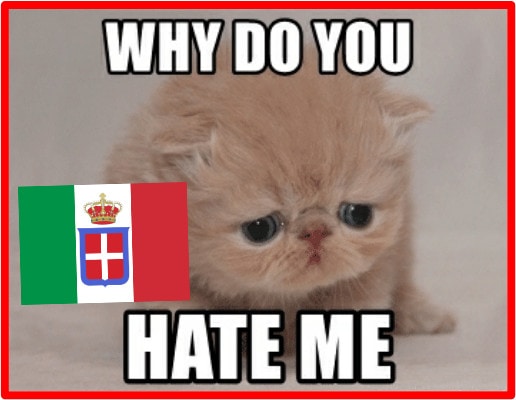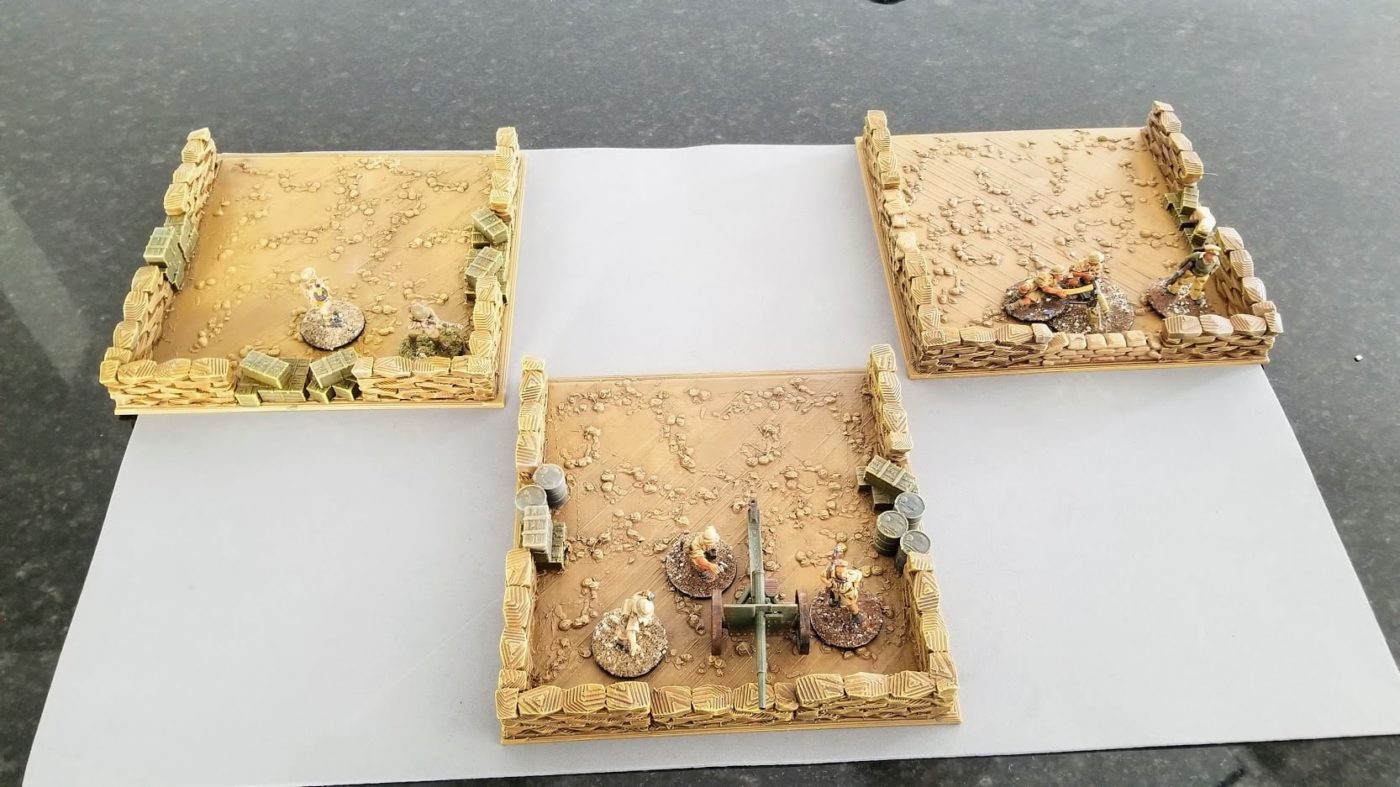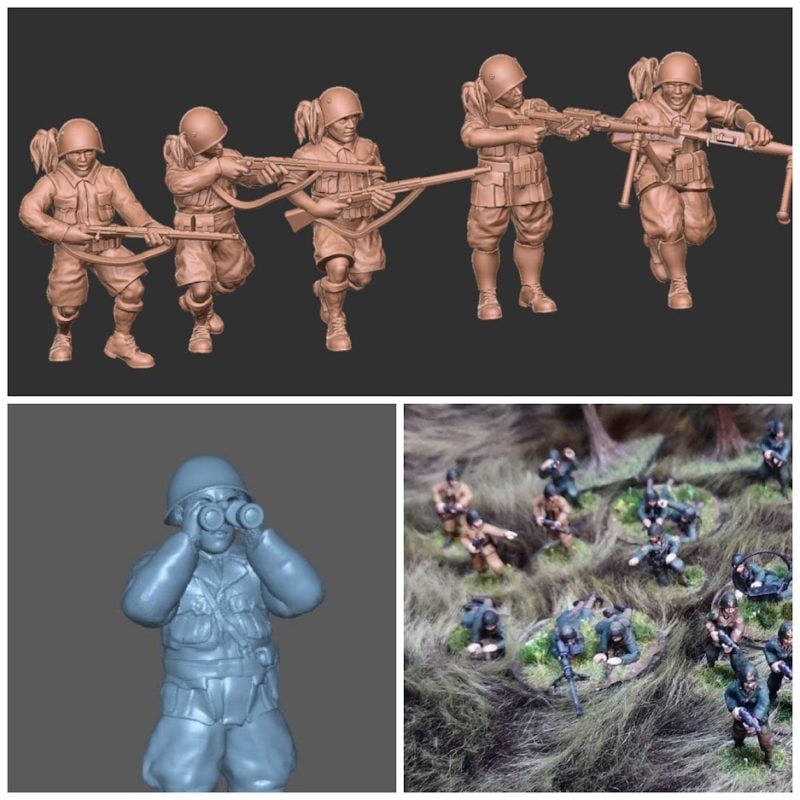Printing and Playing an Italian Army in Bolt Action

Building and Fielding an Italian Army in Bolt Action
** the contents of this article is solely the opinion of the author,
and I alone am responsible for the opinions herein**
Recently the Italian Army has received some overdue attention in miniature gaming. Italy has long relegated to the “Minor Axis power” corner of Bolt Action, despite Italy being considered one of the “Big Three” of the Axis powers. Miniature manufacturers concentrated on the armies of the Germany/USA/ USSR/UK/Japan. Only now has there been sudden burst of interest in the Italian contribution, sparked by the pending release of new plastics from both Wargames Atlantic and Warlord Games, coupled with a new series of campaign books, starting with the “Soft Underbelly” book covering Operation Husky.

So this may be a good time to do a quick review of the Italian army’s role in WW2 and the gaming options open to player and those engaged in 3D printing for the Italian player
The Italian Army – The Rodney Dangerfield of militaries

The Italian army’s performance in WW2 has been so maligned as to become a meme. While there is some basis for criticism, but it is not an accurate representation of the performance of Italian troops in the conflict.
We really need to review how Italy came into the conflict to understand the how Italy ended up in the situation they did.
Italian History in < 400 words
Italy is a relatively young nation, born through the unification of various small states in 1866, the same time the German states were being united. Unlike Germany, Italy was not geographically homogenous, with significant cultural, economical, and even linguistic differences between the regions. Significant parts of Italy remained in a semi-feudal agrarian state.
Although Italy was a member of the pre-war Triple Alliance with Germany and Austria-Hungary, Italy did not immediately enter the Great War. Instead Italy negotiated with both sides before making a mercenary choice to join the Allies in 1915. Italy fielded an army of over 5 million men but suffered tremendous losses in the brutal campaign in the Alpine region. The 1917 Battle of Caporetto was an absolute disaster for the Italians, and only aid from the Western Allies stemmed the Central Powers offensive. The Italian High Command adhered to a “failed frontal assault, rinse and repeat” doctrine. The Italian contribution cost the Italians 420,000 killed and almost 955,000 wounded.

Post-war, Italy found itself exhausted by the war, and felt short-changed in the post-war peace negotiations. Italy was wracked with economic woes and political turmoil. In 1922 this power vacuum was filled when Benito Mussolini’s Black Shirts marched on Rome and seized power.
Mussolini molded Italy into a one-party state. As King Victor Emmanuel remained the Chief of State, Italy maintained a veil of legitimacy internationally. This allowed Mussolini to remain on good terms with the major Western powers, who were far more concerned with the potential rise of Communist doctrine. This détente soured with Mussolini’s unprovoked 1935 invasion of Ethiopia. This effort, involving over 400,000 Italian troops, resulted in spoiling Italy’s international standing as well as exhausting its economy and its military.
Shortly thereafter Italy doubled down and sided with General Franco’s Nationalists in the Spanish Civil War. Eventually Spain committed over 80,000 troops (deemed “volunteers”), and supplied substantial quantities of armaments – artillery, tanks, warplanes, and transport vehicles.

This adventures left the Italian army exhausted, with garrisons committed to far-flung and hostile postings. The expenditure of weaponry and ordnance in these conflicts created a deficit that the limited Italian armaments industry could not make good.
Entering World War Two – dazed and confused
With the outbreak of war in Europe in September 1939, Italy initially held back. Mussolini watched as Germany rolled up resounding victories in Poland and the Nordic countries. As France seemed to be collapsing in June 1940, Mussolini launched a belated assault on the French frontier. This effort resulted in Italian troops being badly mauled by French frontier forces.
Likewise, Italy’s invasion into Egypt in late 1940 was thrown back by badly outnumbered but brilliantly lead British forces. This disaster was followed up with a series of ill-planned and poorly executed ventures. Mussolini even contributed a hapless contribution into the Battle of Britain. This was mated with the bungled invasion of Greece in October 1940.

It seemed everywhere Italy sought martial glory it was quickly exposed to be a paper tiger. They met defeat in Somaliland, East Africa, and the Western Desert. They were rescued from humiliation in their Adriatic adventures by the German invasion of Yugoslavia and Greece. Tomes have since been written suggesting this delayed Operation Barbarossa enough to change the course of history. Mussolini contributed the Italian Eighth Army to invasion of the Soviet Union; this ended in its collapse in Operation Uranus at Stalingrad in the winter of 1942-43.

Why did Italy (mostly) perform so poorly ?
Italy was no Germany. It was a poor country, without natural resources, lacking heavy industry, struggling just to feed itself. Its involvement in the Great War left it exhausted. Its limited military strength was squandered in Mussolini’s adventures in Ethiopia and Spain. Much of its armaments were decades old. A large portion of its artillery was actual old Skoda models captured from the Austro-Hungarians. What little weapon development that took place was geared towards either colonial policing or a future war in the alpine regions. Emphasis on small tankettes like the CV 33/35 made sense if fighting up narrow mountain passes was foreseen as future battlefields. Their most common gun, the 47/32 “elefantino”, was intended as pack weapon. Designed to be broken down easily, it could not be towed any distance, instead needed to be porteed. It wasn’t ideal for mobile warfare.
Italy lacked the manufacturing capacity necessary for modern warfare. In the four years – 1939 to 1943 – Italy produced 83,000 trucks. The U.S. alone produced over 2 million trucks. Italy produced 7,200 guns of all types in the same period; the USSR produced over 500,000 guns (not including mortars). Italy just was not in the same league, production wise, as the other nations it was fighting.
Italy fought in just about every imaginable theatre – Spain, East Africa, North Africa, Greece, the Balkans, the East Front, and on their own homeland from 1943 onwards. Even after the Italian capitulation in July 1943, the Italians split, and fought on both sides. The Italian Co-belligerent Armyfought with the Western Allies, and the Repubblica Sociale Italiana, or R.S. I., who fought with the rump fascist state until April 1945.

So Italian troops were pushovers?
Hardly. Italians repeatedly displayed outstanding tenacity and courage. The last successful cavalry charge in military history was in July, 1942. It was the Charge of the “Savoia Cavalleria” at Izbushensky, and it blunted a Soviet offensive. Frequently in the Western Desert Italians displayed stalwart performance, despite their poor equipment and spotty logistical support.
The post-war stereotype of the Italian soldier, like that of the French soldier, is unwarranted. When led well and motivated, the Italian soldier was resolute and resilient.
Playing the Italian Army in Bolt Action
The Italian player in Bolt Action faces a challenge from the get-go. Unlike any other BA army, the Italian player faces a number of “negative” rules without a counterbalancing beneficial rule. For example the French player suffers from “communication breakdown”, but gains a free artillery piece. The Hungarian or Bulgarian player gets “Axis support” options to purchase German equipment. No such benefits for the Italians. Instead they get saddled with one of three following negative army rules –
Armies of Italy and Axis Minor Powers : “Avanti Savoia” rule : At the start of each turn subtract the number of units lost from those of the enemy; if the result is -3 or worse the Italian basic morale is reduced by 2.If the number is +3 or more, morale is increased by 2.
Western Desert Theatre book : these special rules are limited to this book’s scenarios. In place of the previous general special rules there are new rules to punish the Italian player with, such as,
- “Poor officers” – the officer special bonus only applies to Order rolls of “Ambush”, “Fire” and “Rally”.
- “Prudente”: Italian Infantry units all add a -1 to their Order rolls (not morale rolls).
Italy “Soft Under Belly” campaign book : Modifies the Avanti Savoia rule so that each turn players subtract the number of units lost from those of the enemy; if the result is -3 or worse the Italian basic morale is reduced by 1 but eliminates the bonus if the number of units lost is +3 or more in favour of the Italian player.

Yes, it can be argued that the Italian Army rules have some historical basis, but (opinion of this author alone) they only discourage players from fielding an Italian army. Having different armies add a lot of flavour and variety to the game table. How many “late-war German” armies do we really need? Historically, many armies suffered from supply/morale/officer quality issues but aren’t penalized from the start. For example, those familiar with the history of the Nationalist Chinese, the Romanians, and Hungarians would see the same issues within those forces.
One of the special rules the Italians have – which doesn’t really balance the negative ones but is good to know – is the defensive positions. In scenarios with an identified attacker/defender, and the Italian player has rolled to play as the defender, he can employ the “Defensive strategy” rules. Among them is the following:
“After determining table edges, but before either side deploys any unit, roll a D3 – the result is the number of emplacements available to the (Italian) player. Each emplacement is made of three linear obstacles up to 6″ long and 1″ tall, representing hard cover like sandbags, a section of low wall, or earthwork, which are always placed as pictured. These must all be within 12″ of his table edge.”
I created a free .stl package (link below) to allow you to easily print off three different models of these positions. You will have them ready and won’t have to worry about jerry rigging terrain to simulate such positions.
https://www.wargaming3d.com/product/italian-defensive-position-stls/

That said, let’s do just that – field some Italians!
How do I play Italians?
Playing Italians is going to be a challenge but comes with the benefit of adding something new. It should garner some grudging respect from your opponents. Reading post-tournament posts, I read of more players fielding Italians. If you plan to, you should work out lists that maximize their unique attributes and minimize their built-in negatives.
What are the Italian strong suits?
- Vehicles with lots and lots of machine guns. Seriously, look at the list for Italian AFVs. Many tanks and armoured cars have options for three or four MMGs – the M 15/42 even has five, although that is an error in listing, as the production model did not have two coaxial MMGs. For example, the Italian M 11/39, an early war tank, has hull mounted light ATG, two turret mounted MMGs and a pintle MMG option. It has 8+ armour, and all for 145 points, regular, with the pintle MMG. The soft skin AS 42 Auto-Sahariana is an SAS jeep on steroids, with multiple MMGs mounts plus options for ATR, ATGs and or an autocannon.
- So many gun trucks. The Italians did a great job of improvisation to overcome their supply limitations. They mounted light auto cannons, light and medium howitzers and even super heavy ATGs on trucks, giving an extensive range to add mobile fire support.
- Crazy little L-3 tankettes. Don’t underestimate them. Although they are bizarrely in the tank column, for 70 points you get a closed top little run about with twin MMGs and 7+ armour. Pick the flame thrower option (albeit at the cost of now being “slow”) and you get one of the cheapest flamers in the game at 95 points. It even has a coaxial MMG with that flame thrower, so running out of fuel doesn’t render you impotent.
- A good range of infantry – from inexpensive, inexperienced infantry that are considered “green” without extra cost, to veteran paratroopers, San Marco Marines, Alpini, motor-cycle mounted Bersaglieri or mounted cavalry. Supplemental campaign/theatre books have provided additional units. We can expect more options as the Bolt Action Italian Campaign books move up the boot of Italy.
- Maximizing the defensive special rules when applicable – being able to forward deploy ATGs, the inability of your opponent to order a “run” in the first turn if you are playing the defender, and having your pre-deployed units being able to be on “ambush”. These are limited to scenarios you are playing the defender, but it all helps.
What are the shortcomings?
- The anti-tank options are limited; only an ATR team and A/T grenades if chosen. Only one infantry selection (at time of writing) offers panzerfausts to the Italians, and that is late war parachutists. That time period would restrict them to the R.S.I. component of the post-capitulation Italian fascist state. You may want to look at one of the ATG/mounted ATG options to give some A/T heft to your army.
- You want to avoid losing a bunch of small units, so avoid taking small 5- or 6-man rifle squads to boost your dice count. This will hurt you if your opponent concentrates on taking out your dice to impose the crippling loss of morale should you fall 3 dice behind.
- Your officer may not as much value should you be saddled with the “Poor Officer” rule. That may cause you to rethink the cost of a higher quality HQ if their bonus won’t help in an Advance or Run order situation.
- While their tanks have lots of MGs, the tank guns are somewhat lacking. The “medium” Italian tanks – M13/40, M14/41, and M 15/42s – only have light ATGs. You have to go to their Semovente Assault Guns before your can get a serious ATG in a fully armoured vehicle.
What is out there in metals and plastics?
There is a good selection of metal 28mm Italian figures in many lines – Warlord Games, Perry, Artizan, Empress, Black Tree, Great Escapes Games (they have some great winter Italians!), Askari miniatures, Gaddis Gaming, among others. The new plastic Italians from both Wargames Atlantic and Warlords Games had got a lot of attention. Both kits hold great promise. Wargames Atlantic has a true scaling to their figures which I like personally, but Warlords heroic scale is popular with many players.
The selection of plastic model kits for AFVs, guns and transports used by the Italians is currently limited. There are, however, a good number of resin and metal models out there.
How about 3 D prints?

That’s why we are all here.
We have seen an explosion of input from designers in regard to fill the vacuum left by manufacturers. Both the infantry figures and AFVs/guns and transports are covered off well in .stls, and the choice of expanding rapidly.
Infantry
Checking the Wargaming 3d site you will see several designers and their wares. Iron Chicken has a great platoon offer; his .stls are clean prints of both infantry, support weapons and the Italian 65mm infantry gun. Mr 3d Print has recently offered some very dynamic Italian figures which look outstanding. Calab Miniatures has a good selection of individual figures, which allows you to select the pose you want; the poses are quite innovative.

3D Breeds “March to Hell”, an stand alone entity, series offers up an Italian selection, although their figure’s proportions can be a little off-putting to some.
These lines are sure to expand and warrant keeping an eye on. I know I am anticipating the release of some Italian paratrooper .stls.
Armoured Fighting Vehicles, transports, and guns
I won’t even try to list the various designers and designs available, the selection is wide ranging. You can just do a search of the Wargaming 3d site for “Italian” and see where the wide range on offer.
You should have no trouble printing off a formidable Italian army for any of the many theatres the Italians found themselves in. This range will be expanded upon in the inevitable campaigns books currently in the pipeline.

Viva Italia!
Most of us come to this hobby from a combination of gamesmanship, comradery, and historical interest. If our sole focus was winning, we likely would be in the 40K end of the shop. Playing the Italian army is not the easiest route to the victory podium at a tournament, but it is a fun rabbit hole to fall into, and it keeps the game fresh.
If you have room or time for a new army, consider the Italians.